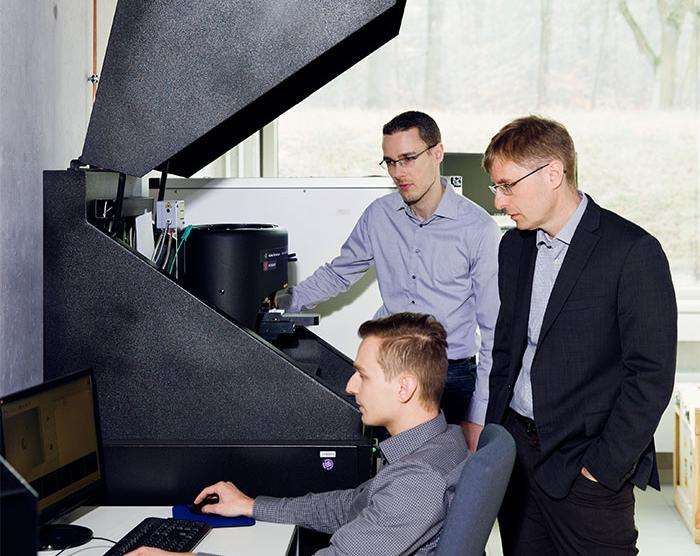Imprinting nano-patterns in metals

Materials scientists at the TU Darmstadt are imprinting nano-patterns in metals, a technology that could give metallic surfaces permanent functionality, like a lotus effect or reduced frictional properties.
A baker specialising in the spiced Spekulatius biscuits eaten in Germany around Christmas time and Paul Braun, a doctoral student at the Physical Metallurgy group in the Department of Materials and Earth Sciences at the TU Darmstadt have one thing in common: they both spend some of their time imprinting designs into materials – the one into biscuit dough; the other into metal. However, whilst the animals, figures, and windmills typically stamped into the Christmas cookies are readily identifiable, Braun's imprints are too small to be invisible by the naked eye. They are formed into the metal using a tiny stamp made of diamond no bigger than the point of a needle. "Diamond is perfect for the task", Braun explains, "as it is an extremely hard material that is all but impervious to wear and tear."
To be able to be used for embossing, the diamond is clamped in a special device, a so called nanoindenter. Actually, the materials scientists at the TU Darmstadt usually use the nanoindenter for complete different purposes, such as testing the hardness, fracture behaviour, and other properties of various materials. These tests all involve the use of a diamond stylus that is pressed into the material being tested, whereby a force is applied and the indentation depth is measured on the nanoscale. In addition, the device can be used in combination with a scanning electron microscope (SEM) to study cracking of thin coatings during the indentation process. Braun's doctoral supervisor Dr. Karsten Durst, Professor of Physical Metallurgy at the TU Darmstadt, explains: "The diamond tip is pressed less than 100 nanometres into the sample during such tests, so that the nanoindenter can be used to explore gossamer-thin layers."
For many years he has been driving the development of this method for materials testing purposes and is now using it to address novel problems. He now plans to use it for the nano-scale imprinting of metal surfaces. This technology, which experts refer to as nano-imprinting, is already being used in conjunction with polymers, for example in the manufacture of plastic chips which include microscopic channels and other structures. Nor is the embossing or imprinting of metal anything new in principle, but it has only ever been used at far larger scales to date for things such as minting coins. According to Durst: "We're right at the beginning of the nano-imprinting of metallic surfaces, and are still looking at the basic principles of this technology".
Hard and finely structured stamps
The first step is the development of suitably hard and finely structured stamps. Doctoral student Braun has already succeeded in creating several of these by re-purposing the diamond tips of a nano-indenter, to which end he travelled to Brno in the Czech Republic to meet with the microscope manufacturer Tescan, who have developed a special ion beam technology. This is usually used for the preparation of samples for examination by electron microscopy. Braun, on the other hand, used the focused ion beam to cut off the top of the diamond probe, to carve a pillar out of the remains of the diamond, and to mill the desired pattern into its top surface. After final ion beam polishing, the stamp was ready for use.
The next question is: what properties does a piece of metal need to have so that it precisely forms the desired surface structure. As every Spekulatius baker knows, the success of the biscuit depends on the consistency of the dough. The same applies, in principle, to the nano-imprinting process: the microstructure of the metal has to be just right to ensure that it "flows" well into the mould. The scientists in Darmstadt want to be able to imprint structures of just 50 nanometres – that's around 1500 times thinner than a human hair! The problem: any metal or alloy will consist of a multitude of tiny, tightly packed grains. For most conventional metals and alloys the diameter of these grains measure well above 1000 nanometres. This means, however, that conventional grain sized metals will resist being pressed into the form of the stamp due to their large grain size. This is why Durst and his colleagues are researching the production of more finely-grained metals, which will fit perfectly within the hollow spaces of the stamps.
More information: Verena Maier et al. Microstructure-dependent deformation behaviour of bcc-metals – indentation size effect and strain rate sensitivity, Philosophical Magazine (2014). DOI: 10.1080/14786435.2014.982741
Hamad ur Rehman et al. Nanoindentation studies of the mechanical properties of the μ phase in a creep deformed Re containing nickel-based superalloy, Materials Science and Engineering: A (2015). DOI: 10.1016/j.msea.2015.03.045
Karsten Durst et al. Dynamic nanoindentation testing for studying thermally activated processes from single to nanocrystalline metals, Current Opinion in Solid State and Materials Science (2015). DOI: 10.1016/j.cossms.2015.02.001
Provided by Technische Universitat Darmstadt




















